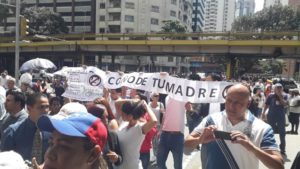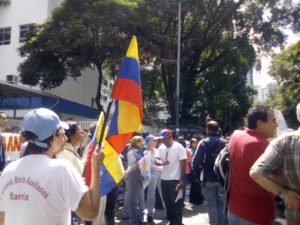Leveraging Barrio Informants, Maduro Weakens Protests in Poor Areas
Operación Sapeo is what the government gives a huge effort to get shantytown residents to snitch out neighbors who join anti-Maduro protests. It’s working.


Photos: Mabel Sarmiento
Unlike on January 23rd, the slums didn’t take to the streets en masse for yesterday’s protest called by Juan Guaidó. Why? Fear. Fear of armed civilian groups. Fear of FAES, the National Police death squad unit. Fear of losing access to subsidized food through CLAP. Fear created by rumors of forced military conscription. And yet, they still expressed their dissatisfaction.
“I think the ‘snitch’ (Sapeo) operation is causing a lot of fear again. Chavistas in the barrio are recording and pinpointing the homes of protesters. That’s why the FAES broke into people’s homes after January 23rd. That’s why many didn’t go out this Wednesday. But it’s a fact that we want Maduro and his people out. We can’t buy food, prices went through the roof, there’s no transport, we have no domestic gas. This isn’t how life is supposed to be,” said Gregorio Damas from El Valle.
Following caretaker President Juan Guaidó’s announcements last Sunday, people rallied on streets and avenues this Wednesday, January 30, between 12:00 m. and 2:00 p.m.
Participation in Eastern Caracas was a given, but the thermometer for protests was the west side. Due to heavy police presence in areas such as La Vega, where neighbors had planned to protest for water, and threats from CLAP people, the streets remained quiet.
Last week, on January 23rd, citizens in Caracas’ barrios went out to protest and demand that Nicolás Maduro immediately hand over power. “I don’t want bonuses, I don’t want CLAP, I just want you to go, Nicolás,” was a cry picked up by the entire city.
After that massive protest, from Petare to El Amparo, slums were swept by FAES operatives. They arrived in hoods, with long weapons, shooting, aiming at women and children. They took prisoners and killed many.
Chavista media doesn’t talk about that. The videos shared on social networks and the testimonies of the victims are the only reliable proof of this flagrant violation against the civil rights enshrined in the Constitution.
The rampant repression, committed by men who were often not identified, soured this Wednesday’s protests, but not people’s desire to be rid of this regime.
People took to the streets in small numbers at midday in Sucre, El Valle, Coche, El Paraíso, San Martín, Caricuao and San Pedro, as well as along the Victoria, Nueva Granada and Fuerzas Armadas avenues, all working class areas. No streets were blocked and there was no repression.
More intimidation
“In my neighborhood, they put up a warning saying that if we go out to protest or bang our pots, we would lose the CLAP and the bonuses,” said Evelyn Mejías. She didn’t stay in Antímano, to the west of the capital. She chose to move to La Candelaria, where people went out with their protest signs despite the harassment from armed groups.
Evelyn said she felt free to express herself: “It’s not like in the barrio. With the FAES crackdown, better not risk it.”
In La Candelaria, the protest filled the Vollmer Avenue. Neighbors and political leaders, health workers and teachers didn’t wait until noon. By 10:00 a.m. they were standing outside the J.M. de los Ríos Children’s Hospital, where four children with  chronic conditions died this month due to lack of medicines and supplies. The NGO Prepara Familia published their names on Twitter and demanded that the state comply with precautionary measures issued by the Inter-American Court of Human Rights. The staff of bank offices in the area also joined the protest with signs made on recycled sheets.
chronic conditions died this month due to lack of medicines and supplies. The NGO Prepara Familia published their names on Twitter and demanded that the state comply with precautionary measures issued by the Inter-American Court of Human Rights. The staff of bank offices in the area also joined the protest with signs made on recycled sheets.
“We want this regime to end, we must keep united and in the streets to pressure them. This rally is to demand humanitarian aid. We don’t want more deaths. We don’t want more hunger,” says one of the demonstrators out loud.
Regime armed groups prowled through this area as well as San Martín, stridently shouting their support for Maduro, while people demanded “Freedom” amidst cheers from the crowd.
Near Sambil La Candelaria, relatives of political prisoners and FAES victims offered their testimonies, despite the presence of National Police officers. One of them, Julio César Reyes, a community leader in Catia, denounced that he was held at gunpoint on Sunday in front his wife and kids while they were standing in front of their house, protesting the country’s crisis. His case isn’t isolated, chavista informers sent the police on him, as they’ve done to many others.
He also chose to go to La Candelaria as a middle ground to demonstrate, like other citizens in similar conditions.
“The barrios haven’t come out in a week, but that doesn’t mean people there aren’t angry. So many things are happening, so fast. We have to help the people, teach them to defend themselves against these attacks,” said Jóvito Páez, who joined the protest at J.M. de Los Ríos Hospital.
Street protests were also diminished by the rumor about conscription operations, although human rights organizations haven’t confirmed them. People were afraid and in low spirits; some parents even rushed to pick up their kids from school mid-morning because they got wind that National Guard trucks were taking them from their classrooms.
Guaidó was in the Central University of Venezuela, also heavily guarded by the police, and met with students who gave him a medical coat full of signatures. Guaidó ratified that the protest remains active until the arrival of humanitarian aid, which was the purpose of Wednesday’s protests.
Caracas Chronicles is 100% reader-supported.
We’ve been able to hang on for 22 years in one of the craziest media landscapes in the world. We’ve seen different media outlets in Venezuela (and abroad) closing shop, something we’re looking to avoid at all costs. Your collaboration goes a long way in helping us weather the storm.
Donate




